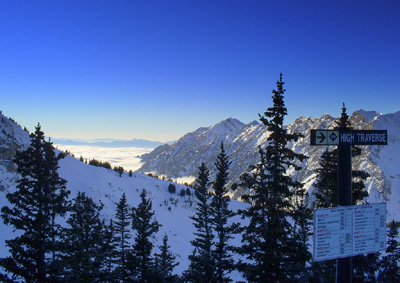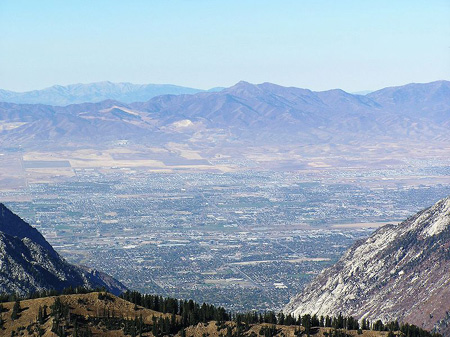45 Environmental Impacts of Urban Form
Cities have many different impacts on the environment. Furthermore, different types of cities will have different environmental impacts. Here we consider some major contributors. As you read about these contributors, think about how they might be interconnected with one another.
Transportation Mode
A transportation mode is a way of getting around, such as walking, driving, bicycling, bus, or subway. Non-motorized transportation – walking, bicycling, etc. – is almost always quite a lot more efficient than motorized transportation. Bicycling is actually more efficient than walking because there is less friction with the ground. Walking can achieve the equivalent of about 350 miles per gallon of gasoline; cycling can achieve the equivalent of about 700 miles per gallon of gasoline. However, the difference between the two is smaller once the energy required to produce and recycle/dispose of the bicycle is factored in. And of course, the energy here comes not from gasoline but from whatever food is being eaten by the person walking. The overall environmental impact, then, depends on what types of foods are being eaten.
The efficiency of a car, bus, or train depends heavily on how many people are in it. A bus at average and maximum passenger loads gets about 40 and 330 miles per gallon per passenger respectively. Note that this does not factor in the energy consumed by the passengers’ bodies as they sit or stand in the bus. Trains can be even more efficient than buses because their metal wheels and rails have less friction than buses’ rubber tires on pavement. Furthermore, trains can move larger volumes of passengers. A bus or train with one passenger will consume a lot more energy than a car with one person in it. This means that cars are not necessarily the least efficient option.
Consider This: Transit and Traffic: A Collective Action Problem
Have you ever been stuck in traffic? Did you enjoy it? Most people don’t. We would rather get to our destination sooner.
If you live in an area where both cars and transit are options, then you may face a collective action problem. In this scenario, regardless of what everyone else does, you’ll reach your destination faster if you drive. However, if everyone takes transit, then everyone will reach their destinations faster than if everyone drives. This is because transit can move more people along a street per unit of time. It’s like using a big fire hydrant hose to move water instead of a little gardening hose. Transit can do this because, in a bus or train, people can sit or stand right next to each other, whereas in cars there’s a lot more space between each individual person. Furthermore, when streets get crowded, there can be more people taking transit, meaning that the transit system can run vehicles more frequently and people have to wait less time for them.
Given what you know about collective action, how would you solve this problem?
Buildings
Buildings are perhaps the single biggest contributor to the environmental impacts of cities. There are major impacts throughout the lifecycle of a building. When buildings are constructed, they tend to require a lot of natural resources for the building materials and energy for the construction process. Then, once they’ve been built, they use a lot of energy for heating, air conditioning, lighting, and appliances. Finally, when the building is no longer desired, something must be done with the building materials.
One way to reduce the environmental impact of buildings is to use less building per person. When people live in smaller residences and work in smaller offices, their buildings will have lower environmental impacts. Apartment buildings can save a lot of energy in heating and air conditioning because apartments share walls with each other and thus don’t lose as much heat to the outside. Smaller residences also discourage people from buying lots of stuff because there is less space to put the stuff. This avoids the environmental impacts of manufacturing the stuff.
Green Buildings
The U.S. Green Building Council (USGBC) has implemented the LEED® program since 1998 to encourage sustainable building design, construction, operation, and maintenance. LEED stands for Leadership in Energy and Environmental Design and serves as a “yardstick” to measure the sustainability of structures by design and construction industry. An LEED-certified building is often referred to as a green or sustainable building. If a building meets sustainability criteria, it receives LEED certification on one of four levels (LEED Certified, Silver, Gold or Platinum, from the lowest to the highest level). The rating is based on the points a building can earn for sustainable building site selection, maximized water use efficiency, minimized energy use and effect on the atmosphere, advancements in indoor environmental quality (e.g., material, mechanical, and lighting performance).
Consider This: LEED buildings at Penn State
For example, Penn State’s (UP campus) Stuckeman Family Building, home of the School of Architecture and Landscape Architecture, is a LEED Gold complex thanks to its sustainable features such as an exterior construction of recycled copper and durable brick, rainwater harvesting and recycling for landscape irrigation, intelligent lighting control system, and energy-efficient motorized windows that take advantage of natural ventilation (Probing Question: What is a LEED building?).
Air Quality
Cars, buses, power plants, factories, and fireplaces all put pollution into the air, affecting the health of everyone who breathes the air in. All else equal, cities with more of these activities will have more air pollution. But all is not always equal. Some urban areas have more air pollution even when they have the same amount of polluting activities. Here, the environment can be a big factor.
One way that a city can have worse air quality is if it is in an area with a temperature inversion. Usually, air along the surface is warmer because it receives warmth from the ground. Colder air is more dense, which is why we use hot air balloons to go up into the sky. When warmer air is along the surface, that air rises and mixes with the colder air above. This pulls pollution from the ground into the air above where it won’t be breathed in by people, thereby cleaning the surface air that we breathe. A temperature inversion is a scenario in which colder air sits along the surface and warmer air lies above. When colder air is along the surface, it doesn’t rise up into the sky and mix with the air above. Thus cities with temperature inversions tend to have worse air quality.
Temperature inversions are usually found in cities with a source of colder air and mountains that trap the cold air in. One example is Los Angeles, which receives cool air in from the ocean. Another is Salt Lake City, whose surrounding mountains also make for famous ski resorts. Here is a photograph from the ski slopes of the Alta resort. Mountains in the background can be seen poking up above low-lying clouds and smog, the result of a temperature inversion.

Here’s a view from a different site, showing the city in the valley below:


